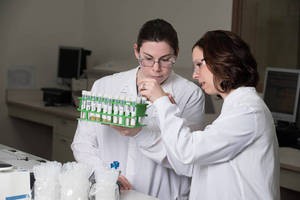Methods of Eliminating Interference in the Detection of Metal Cadmium in Water
Coexisting ions and compounds in groundwater and surface water do not interfere with the determination at common concentrations. When the concentration of calcium is higher than 1000mg/L, the absorption of cadmium is inhibited. When the concentration is 2
Working principle and classification of water quality detection spectrophotometer
At present, spectrophotometry is one of the commonly used detection methods in water quality testing, especially in the determination of water samples with relatively low content, which has the advantages of simple operation, high accuracy and high sensit
The role of metal indicator in water quality testing
When detecting water quality, different items use different reagents. For example, in the process of coordination titration of heavy metals in water, in order to obtain relevant parameters more accurately, indicators are used to assist detection. The reag
Detection method of heavy metal cadmium in water
The heavy metal cadmium in the water mainly comes from the mining of different minerals, such as coal mines, aluminum mines and copper mines. In practical applications, cadmium detection methods mainly use atomic absorption methods, such as direct inhalat
Classification and selection methods of chemical reagents for water quality testing
Regardless of which method you use when conducting water quality testing, various chemical reagents are used in the experiment. Therefore, mastering the classification, specifications, properties and methods of use of water quality testing reagents is an
Problems that need to be paid attention to when detecting aluminum content in water
Most of the aluminum in daily drinking water comes from the alum used in the treatment. Under normal circumstances, the content of aluminum in natural water is actually very low. In addition, the "Sanitary Standards for Drinking Water" clearly s
Method for detecting dissolved solids in water
There are two types of solids in water, soluble and insoluble, but there are only two types of total solids and soluble solids in the measurement. In the previous article, we have already introduced how to use the gravimetric method to detect total solids
Problems that need to be paid attention to when detecting dissolved oxygen in water by iodometry
The principle of iodometric detection of dissolved oxygen in water is mainly through the oxidation of divalent manganese ions by dissolved oxygen in water to trivalent or tetravalent manganese in an alkaline solution. In this way, the dissolved oxygen is
New silver salt spectrophotometric method to detect arsenic in water
In the "Urban Water Supply Quality Standard", one of the toxicological indicators clearly stipulates that the arsenic content in drinking water should not exceed 0.01mg/L. It can be seen that the excessive arsenic content in water is a very seri
Matters needing attention in the detection and sampling of volatile phenols in water
The detection of volatile phenols in water is more complicated than some other substances. The main reason is that the volatile phenol in the water is easily polluted and interfered during the collection and detection process, which leads to inaccurate me













